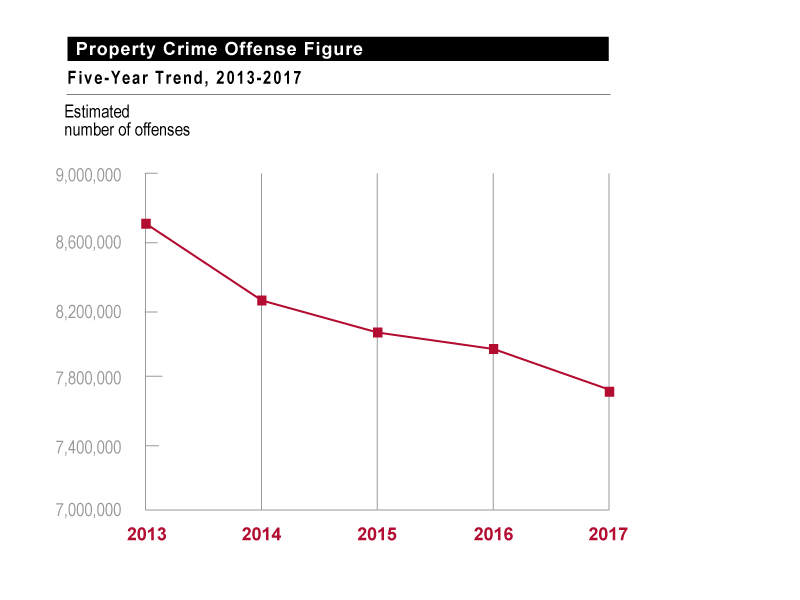
Property Crime
Definition
In the FBI’s Uniform Crime Reporting (UCR) Program, property crime includes the offenses of burglary, larceny-theft, motor vehicle theft, and arson. The object of the theft-type offenses is the taking of money or property, but there is no force or threat of force against the victims. The property crime category includes arson because the offense involves the destruction of property; however, arson victims may be subjected to force. Because of limited participation and varying collection procedures by local law enforcement agencies, only limited data are available for arson. Arson statistics are included in trend, clearance, and arrest tables throughout Crime in the United States, but they are not included in any estimated volume data. The arson section in this report provides more information on that offense.
Data collection
The data presented in Crime in the United States reflect the Hierarchy Rule, which requires that only the most serious offense in a multiple-offense criminal incident be counted. In descending order of severity, the violent crimes are murder and nonnegligent manslaughter, rape, robbery, and aggravated assault, followed by the property crimes of burglary, larceny-theft, and motor vehicle theft. Although arson is also a property crime, the Hierarchy Rule does not apply to the offense of arson. In cases in which arson occurs in conjunction with another violent or property crime, both crimes are reported.
Overview
- In 2017, there were an estimated 7,694,086 property crime offenses in the nation. The 2-year trend showed that property crime offenses declined 3.0 percent in 2017 when compared with the 2016 estimate. The 10-year trend showed that property crime offenses decreased 21.3 percent in 2017 when compared with the 2008 estimate. (See Tables 1 and 1A.)
- In 2017, the rate of property crime was estimated at 2,362.2 per 100,000 inhabitants, a 3.6 percent decrease when compared with the 2016 estimated rate. The 2017 property crime rate was 13.6 percent less than the 2013 estimate and 26.5 percent less than the 2008 estimate. (See Tables 1 and 1A.)
- Larceny-theft accounted for 71.7 percent of all property crimes in 2017. Burglary accounted for 18.2 percent, and motor vehicle theft for 10.0 percent. (Based on Table 1.)
Property Crime Figure
This figure is a line graph that presents the trend in the estimated number of property crimes for the nation from 2013 to 2017. In 2013, there were 8,651,892 property crimes. In 2014, there were 8,209,010 property crimes. In 2015, there were 8,024,115 property crimes. In 2016, there were 7,928,530 property crimes. In 2017, there were 7,694,086 property crimes. The figure is based on statistics from Table 1.

Burglary
Larceny-theft
Motor Vehicle Theft
Arson
Metropolitan Statistical Areas (MSAs) (Table 6)
Expanded Offense Data

